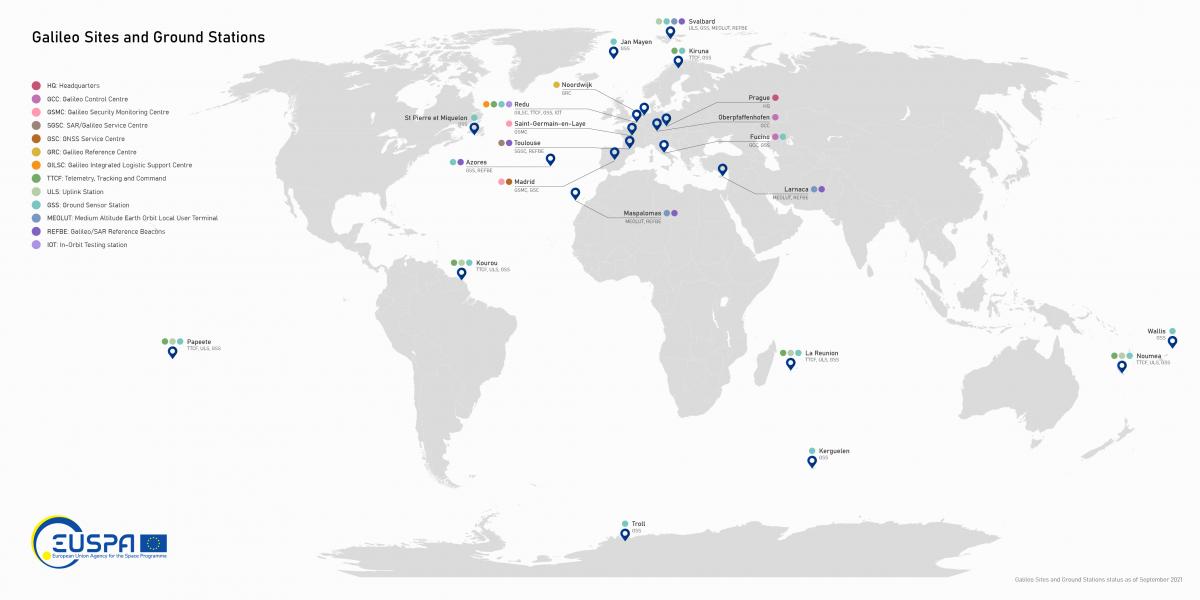The Galileo system is comprised of numerous components, including the satellites in space, a ground segment across several locations and end users.
Space Segment
The Galileo space segment is defined as a 24/3/1 Walker constellation: 24 nominal Medium Earth Orbit (MEO) satellites are arranged in 3 orbital planes, with their ascending nodes uniformly distributed at intervals of 120 degrees, inclined at 56 degrees with respect to the Equator. The constellation may be complemented by Galileo auxiliary satellites, which occupy orbital slots that are not part of the baseline constellation and are not defined a priori. For more details about constellation information, please visit the Orbital and Technical Parameters section.
Ground Segment
The Galileo ground segment consists of two Galileo Control Centres (GCC) situated in Oberpfaffenhofen (Germany) and Fucino (Italy).
Each GCC manages 'control' functions supported by a Ground Control Segment (GCS) and 'mission' functions, supported by a dedicated Ground Mission Segment (GMS):
- The GCS handles spacecraft housekeeping and constellation maintenance by means of the network of TT&Cs stations globally distributed. The scope of this functionality includes control and monitoring of the satellites and payload, planning and automation functions that allow safe and correct operations to take place and the support of payload related operations.
- The GMS determines the navigation and timing data part of the navigation messages by means of the network of GSSs. The GMS communicates with the Galileo satellites through the network of ULSs.
The GMS and GCS interface the satellites with a worldwide network of ground stations implementing monitoring and control functions:
- Galileo Sensor Stations (GSS), which collect and forward Galileo SIS measurements and data to the GCCs in real time.
- Galileo Uplink Stations (ULS), which distribute and uplink the mission data to the Galileo constellation.
- Telemetry, Tracking & Control stations (TT&C), which collect and forwards telemetry data generated by the Galileo satellites, and distribute and uplinks the control commands required to maintain the Galileo satellites and constellation.
Click to enlarge
Map of the Galileo Sites and Ground Stations
The Galileo core infrastructure is complemented by services facilities which support the provision of the Galileo services:
- The European GNSS Service Centre (GSC): is the interface between the Galileo Initial OS and CS user communities and the Galileo system (additional information can be found in the section European GNSS Service Centre). This facility is located in Torrejón (Spain).
- The Geodetic Reference Service Provider (GRSP): supports the GCC in realising the Geodetic Reference Service Provider (GTRF), consistently with the International Terrestrial Reference Frame (ITRF).
- The Time Service Provider (TSP): supports the GCC in the realisation of the Galileo System Time (GST) and its alignment to the Coordinated Universal Time (UTC).
- The Galileo Security Monitoring Centre (GSMC): in charge of monitoring the system security. These facilities are located in St. Germain-en-Laye (France) and Madrid (Spain).
- The SAR/Galileo Data Service Provider (SGDSP) is the entity in charge of the coordination of the operations related to the SAR/Galileo service. This facility is located in Toulouse (France).
- The Galileo Reference Centre (GRC): is responsible for monitoring and assessment of the performance of the Galileo services, completely independently from the Galileo core infrastructure and its operations. This facility will be located in Noordwijk (The Netherlands).
Click to enlarge
User Segment
The Galileo user segment is composed by all the compatible receivers and devices which collect the Galileo SIS and compute their location. There are different users´ communities depending on the application and covering a wide range, from transport to timing applications.

